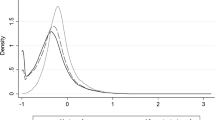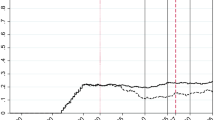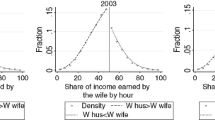Abstract
Using the Luxembourg Income Study data we examine married women's dependency on their husbands' earnings in nine Western industrialized countries: Australia, Belgium, Canada, Finland, Germany, the Netherlands, Norway, Sweden, and the United States. When we examine the level and degree of dependency, and the labor force participation of married women across countries, the nine countries fall into the three clusters delineated in Esping-Andersen's welfare states typology. But when we examine the determinants of the dependency within each country, the clustering disappears. Wives' dependency increases with age, the presence of young children, and the number of children. It is reduced when wives' labor force participation and education are high relative to their husbands' and in families that rely more on unearned sources of income. The similarity of patterns across countries suggests that gender differences in the work-family nexus are deeply entrenched in all countries and continue even in the face of very active social policy to minize their effects.
Similar content being viewed by others
References
Bernhart, Eva M. 1992. “Working Parents in Sweden: An Example for Europe?” Stockholm Research in Demography, No. 66. Stockholm, Sweden: Stockholms Universitet.
Blau, Francine D. and Marianne Ferber. 1992. The Economics of Women, Men, and Work. Second Edition. Englewood Cliffs, NJ: Prentice-Hall.
Blau, Francine D. and Lawrence M. Kahn. 1992. “The Gender Earnings Gap: Some International Evidence.” NBER Working Paper Series.
Bjorklund, Anders. 1992. “Rising Female Labour Force Participation and the Distribution of Family Income-the Swedish Experience.” Acta Sociologica 35:299–309.
Brines, Julie. 1994. “Economic Dependency, Gender, and the Division of Labor at Home.” American Journal of Sociology 100 (November):652–53.
Burkhauser, Richard, Greg J. Duncan, Richard Hauser, and Ronald Bernsten. 1990. “Economic Burdens of Marital Disruptions: A Comparison of the United States and the Federal Republic of Germany.” Review of Income and Wealth 36 (December):319–333.
Bussemaker, Jan and Kees van Kersbergen. 1994. “Gender and Welfare States: Some Theoretical Reflections.” Chapter 2 in D. Sainsbury, (ed.) Gendering Welfare States. Thousand Oaks, CA: Sage Publications.
Cancian, Maria, Sheldon Danziger, and Peter Gottschalk. 1993. “Working Wives and Family Income Inequality Among Married Couples” in Sheldon Danziger and Peter Gottschalk (eds.) Uneven Tides: Rising Inequality in America. New York: Russell Sage.
Casper, Lynne, Sara McLanahan, and Irwin Garfinkel. 1994. “The Gender-Poverty Gap: What Can We Learn from Other Countries.” American Sociological Review 59(4): 594–605.
Collins, Randall. 1991. “Women and Men in the Class Structure” in Rea Lesser Blumberg (ed.) Gender, Family, and Economy, Newbury Park, CA: Sage Publications
Esping-Andersen, Gosta. 1990. The Three Worlds of Welfare Capitalism. New Jersey, Princeton University Press.
Ferree, Myra Marx. 1990. “Beyond Separate Spheres: Feminism and Family Research.” Journal of Marriage and the Family 52 (4): 866–884.
Gornick, Janet D. and Jerry A. Jacobs. 1998. “Gender, the Welfare State, and Public Employment: A Comparative Study of Seven Industrialized Countries” American Sociological Review 63 (October): 688–710.
Gornick, Janet. 1995. “Women's Work and Women's Wages in Comparative Perspective.” Paper presented at the Second U.S. LIS Workshop. Washington, DC: Bureau of Labor Statistics.
Hayghe, Howard. 1993. “Contributions of Working Wives to Family Income.” Monthly Labor Review 116 (August):42.
Hobson, Barbara. 1990. “No Exit, No Voice: Women's Economic Dependency and the Welfare State.” Acta Sociologica 3:235–250.
Hoem, J.M. 1990. “Social Policy and Recent Fertility Change in Sweden.” Population and Development Review 16(Dec.):735–748.
Hofferth, Sandra L. and Sharon Gennis Deich. 1994. “Recent U.S. Child Care and Family Legislation in Comparative Perspective” Journal of Family Issues 15(3):424–448.
LIS-CEPS (1994). LIS Information Guide. Walderdange, Luxembourg.
Maxwell, Nan L. 1990. “Changing Female Labor Force Participation: Influences on Income Inequality and Distribution.” Social Forces 4:1251–1266.
McLanahan, Sara, Annemette Sorensen, and Lynne Casper. 1992. “Women's Status in Family and Work Roles in Eight Industralized Countries.” Presented at the IUSSP seminar on “Gender and Family Change in Industrialized Countries” in Rome, Italy.
O'Neill, June, and Solomon Polacheck. 1993. “Why the Gender Gap in Wages Narrowed in 1980s.” Journal of Labor Economics 11(part I):205–228.
Orloff, Ann S. 1993. “Gender and the Social Rights of Citizenship.” American Sociological Review 58(3): 303–328.
Pahl, Jan. 1983. “The Allocation of Money and the Structuring of Inequality within Marriage.” Sociological Review 31: 237–262.
Sainsbury, Diane. 1994. Gendering Welfare States. Thousand Oaks, CA: Sage Publications.
Schmidt, Manfred G. 1993. “Gendered Labour Force Participation” in Francis G. Castles' Families of Nations: Patterns of Public Policy in Western Democracies. Dartmouth Publishing Company, Brookfield, VT.
Sorensen, Annemette and Sara McLanahan. 1987. “Married Women's Economic Dependency, 1940–1980.” American Journal of Sociology 3:659–687.
Sorrentino, Constance. 1990. “The Changing Family in International Perspective.” Monthly Labor Review 113(3):41–58.
Spain, Daphne and Suzanne Bianchi. 1996. Balancing Act: Motherhood, Marriage, and Employment of American. Russell Sage Foundation, New York, NY.
Treas, Judith. 1987. “The Effect of Women's Labor Force Participation on the Distribution of Income in the United States.” Annual Review of Sociology 13:259–288.
Ward, Kathryn. 1993. “Reconceptualizing World Systems Theory to Include Women.” in Paula England (ed.) Theory on Gender/Feminism on Theory. New York: Aldine de Gruyter
Author information
Authors and Affiliations
Additional information
Her current research focuses on gender inequality and parents' time allocation between work and family.
She conducts research on various aspects of family demography, including household and family characteristics, co-resident grandparent families, cohabitation, and child care. With Suzanne Bianchi, she is completing a research monograph on trends in the American family.
Her research focuses on gender, work, and family issues.
Rights and permissions
About this article
Cite this article
Bianchi, S.M., Casper, L.M. & Peltola, P.K. A cross-national look at married women’s earnings dependency. Gend. Issues 17, 3–33 (1999). https://doi.org/10.1007/s12147-999-0001-0
Issue Date:
DOI: https://doi.org/10.1007/s12147-999-0001-0




